Instruction
How to make six-footers: 10 Rules From Dave Stockton

By Dave Stockton
With Guy Yocom
Photo By Scott Mcdermott
October 2008
1. Take “try” out of the equation
When I faced a 15-foot putt to win the 1976 PGA Championship, the amount of time I took surprised a lot of people. Instead of grinding over it, I took less time than usual — 15 seconds in all. But I did not rush. I knew that if I got hung up dwelling on how much the putt meant, my chances of holing it would have dropped dramatically.
The moment you try to make a putt, you’ll miss it. Conscious effort doesn’t work. Try this experiment: Get a pen and paper and jot your signature. Now write your name a second time, trying to duplicate your first signature exactly. Chances are you’ll make a mess of it, because instead of doing it automatically, you’re now applying conscious effort. Your approach to the six-footer should be like signing your name: Do it briskly and subconsciously.
2. Think speed more than line
Speed and line are equally important, but the amateur tends to be preoccupied with the line. As you read the green, do it with the idea that you’ll roll the ball 16 inches past the hole — if you miss. After you’ve set up and taken dead aim, don’t give the line another thought. Avoid being too aggressive with the six-footer, because the edges of the hole might come into play and cause a nasty lip-out.
3. Stay away from dead straight
When Tiger Woods faced that 12-foot putt on the 72nd hole at Torrey Pines to send the U.S. Open into a playoff, he called in his caddie, Steve Williams, to help with the read. I’ll bet Tiger saw the putt as breaking to the left but was bothered by a hunch that it might be dead straight. If there’s one thing a good putter hates, it’s an absolutely straight putt. The reason is, if you start the putt straight, you have a margin for error of only half a cup on either side. Tiger needed Steve to confirm that the putt would break left, because the entire cup would be exposed if Tiger started the ball to the right. The putt indeed broke a couple inches to the left, and Tiger snuck it in on the right edge of the hole.
If the putt for all the marbles looks straight, look again. Study the area near the hole. Remember, the ball will be rolling so slowly when it gets within two feet that even the tiniest slope will cause it to break. Try to at least favor one side.
stockton
4. You’ve already made the putt
You might have heard that it’s helpful to form a positive image of the ball going in, but you should take it further than that. Imagine the ball tracking the entire six feet, as though you’re watching a video replay of the putt dropping. This image should be so convincing that, if the putt doesn’t fall, you should be shocked. That’s how I feel when I’m putting well — I’m absolutely stunned when the ball doesn’t go in.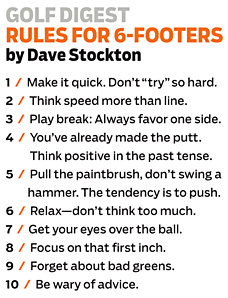
Do everything you can to place the six-footer in the past tense. How many times have you missed a putt, raked it back for another try and instinctively knocked it in? Adopt this “second chance” mentality on your first putt.
5. Be a painter, not a carpenter
For the good putter, the most common miss under pressure is the push. When the heat is on, there’s a tendency to hit at the ball instead of stroking through it. Like driving a nail with a hammer, the putter stops abruptly at impact. It doesn’t release to a square position, and the clubface is aimed to the right. Putt as though you’re pulling a paintbrush, your hands leading and the clubhead trailing as you stroke through.
6. Your last thought: none at all
You should have no coherent thought as you draw the putter back. Avoid saying an actual word or phrase to yourself, even a seemingly positive one such as smooth. All it will do is block the overall sense of flow you must feel to make a good stroke. The only “thought” should be a vague feeling of relaxation, readiness and rhythm. All you’re doing is allowing your subconscious mind to take over so you can invite that wonderful sense of feel where you know the putt is going to go in. Remember, there is no actual language when you’re in that sharp mental state called The Zone.
7. Get your eyes over the ball
Putting mechanics are mostly a matter of preference, but there is one universal rule for putts from six feet and in: Eyes over the ball. For most players, that means standing closer to the ball. This simplifies things enormously. It’ll help you swing the putter straight back and through. It’ll make you less handsy and decrease your chances of fanning the face open and closed excessively. And you’ll see the line better. Come to think of it, it’s a good rule for all putts.
8. Focus on that first inch
In determining the line of the putt, the only area of true precision is the first inch the ball travels. If you’ve read the putt correctly, all you need to do is make the ball roll over a spot one inch in front of it. Be painstaking about that inch. At address, keep your eyes riveted on the spot. Your biggest priority is to keep your eyes still until the ball has traveled one inch past impact. This will keep your head from moving, which is a cardinal sin. Even if you feel anxious, focusing on that all-important spot will guarantee a smooth stroke.
stockton
9. Forget about bad greens
Under pressure, all of your senses are heightened. There is a tendency to see more obstacles than usual along the line — scuff marks, ball marks, footprints, disruptions in the grain and so on. Ignore them. If you strike the ball solidly and impart a true roll, the chances of anything knocking the putt off line are remote. If a spike mark is so significant that you’re sure it will affect the roll, play a shade less break and roll the ball with a bit more speed to avoid it.
10. Take advice with a grain of salt
Most amateur golf is played at four-ball match play. If you’re going to use your partner for reading greens, make sure he knows how you read putts and how firmly you hit them. The best partner I ever had was Al Geiberger. We did well in the old “CBS Golf Classic” series, because our putting styles were similar. When Al said, “It breaks half a cup,” I knew he said it knowing how hard I would stroke the putt. Whether it’s a member-guest or your weekend game, see how the two of you read putts. Make it a focal point of your partnership.
Read More http://www.golfdigest.com/magazine/2008-10/stocktonrules#ixzz1fdC8mhRx
- LIKE8
- LEGIT2
- WOW0
- LOL0
- IDHT0
- FLOP0
- OB0
- SHANK0
Instruction
The Wedge Guy: The easiest-to-learn golf basic

My golf learning began with this simple fact – if you don’t have a fundamentally sound hold on the golf club, it is practically impossible for your body to execute a fundamentally sound golf swing. I’m still a big believer that the golf swing is much easier to execute if you begin with the proper hold on the club.
As you might imagine, I come into contact with hundreds of golfers of all skill levels. And it is very rare to see a good player with a bad hold on the golf club. There are some exceptions, for sure, but they are very few and very far between, and they typically have beat so many balls with their poor grip that they’ve found a way to work around it.
The reality of biophysics is that the body moves only in certain ways – and the particulars of the way you hold the golf club can totally prevent a sound swing motion that allows the club to release properly through the impact zone. The wonderful thing is that anyone can learn how to put a fundamentally sound hold on the golf club, and you can practice it anywhere your hands are not otherwise engaged, like watching TV or just sitting and relaxing.
Whether you prefer an overlap, interlock or full-finger (not baseball!) grip on the club, the same fundamentals apply. Here are the major grip faults I see most often, in the order of the frequency:
Mis-aligned hands
By this I mean that the palms of the two hands are not parallel to each other. Too many golfers have a weak left hand and strong right, or vice versa. The easiest way to learn how to hold the club with your palms aligned properly is to grip a plain wooden ruler or yardstick. It forces the hands to align properly and shows you how that feels. If you grip and re-grip a yardstick several times, then grip a club, you’ll see that the learning curve is almost immediate.
The position of the grip in the upper/left hand
I also observe many golfers who have the butt of the grip too far into the heel pad of the upper hand (the left hand for right-handed players). It’s amazing how much easier it is to release the club through the ball if even 1/4-1/2″ of the butt is beyond the left heel pad. Try this yourself to see what I mean. Swing the club freely with just your left hand and notice the difference in its release from when you hold it at the end of the grip, versus gripping down even a half inch.
To help you really understand how this works, go to the range and hit shots with your five-iron gripped down a full inch to make the club the same length as your seven-iron. You will probably see an amazing shot shape difference, and likely not see as much distance loss as you would expect.
Too much lower (right) hand on the club
It seems like almost all golfers of 8-10 handicap or higher have the club too far into the palm of the lower hand, because that feels “good” if you are trying to control the path of the clubhead to the ball. But the golf swing is not an effort to hit at the ball – it is a swing of the club. The proper hold on the club has the grip underneath the pad at the base of the fingers. This will likely feel “weak” to you — like you cannot control the club like that. EXACTLY. You should not be trying to control the club with your lower/master hand.
Gripping too tightly
Nearly all golfers hold the club too tightly, which tenses up the forearms and prevents a proper release of the club through impact. In order for the club to move back and through properly, you must feel that the club is controlled by the last three fingers of the upper hand, and the middle two fingers of the lower hand. If you engage your thumbs and forefingers in “holding” the club, the result will almost always be a grip that is too tight. Try this for yourself. Hold the club in your upper hand only, and squeeze firmly with just the last three fingers, with the forefinger and thumb off the club entirely. You have good control, but your forearms are not tense. Then begin to squeeze down with your thumb and forefinger and observe the tensing of the entire forearm. This is the way we are made, so the key to preventing tenseness in the arms is to hold the club very lightly with the “pinchers” — the thumbs and forefingers.
So, those are what I believe are the four fundamentals of a good grip. Anyone can learn them in their home or office very quickly. There is no easier way to improve your ball striking consistency and add distance than giving more attention to the way you hold the golf club.
More from the Wedge Guy
- The Wedge Guy: Golf mastery begins with your wedge game
- The Wedge Guy: Why golf is 20 times harder than brain surgery
- The Wedge Guy: Musings on the golf ball rollback
- LIKE85
- LEGIT13
- WOW6
- LOL1
- IDHT0
- FLOP4
- OB1
- SHANK8
Instruction
Clement: Stop ripping off your swing with this drill!

Not the dreaded headcover under the armpit drill! As if your body is defective and can’t function by itself! Have you seen how incredible the human machine is with all the incredible feats of agility all kinds of athletes are accomplishing? You think your body is so defective (the good Lord is laughing his head off at you) that it needs a headcover tucked under the armpit so you can swing like T-Rex?
- LIKE0
- LEGIT2
- WOW2
- LOL0
- IDHT0
- FLOP0
- OB0
- SHANK2
Instruction
How a towel can fix your golf swing
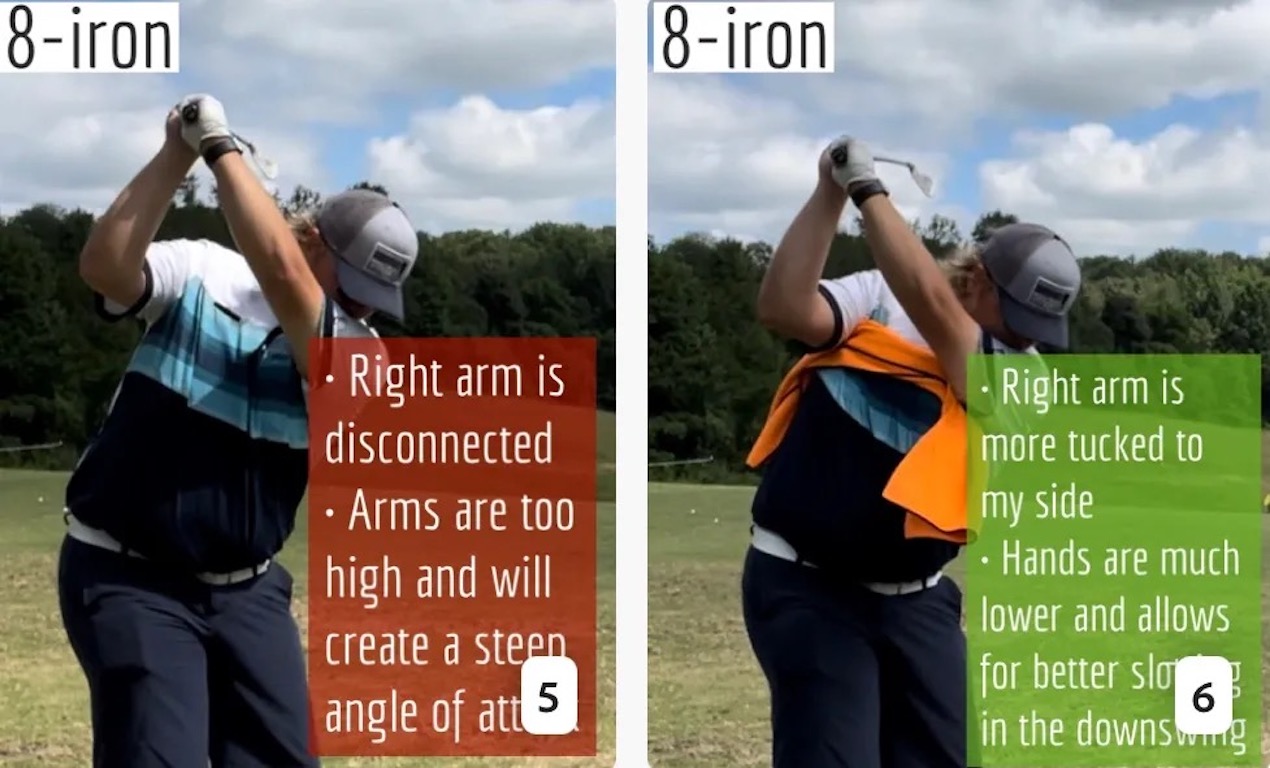
This is a classic drill that has been used for decades. However, the world of marketed training aids has grown so much during that time that this simple practice has been virtually forgotten. Because why teach people how to play golf using everyday items when you can create and sell a product that reinforces the same thing? Nevertheless, I am here to give you helpful advice without running to the nearest Edwin Watts or adding something to your Amazon cart.
For the “scoring clubs,” having a solid connection between the arms and body during the swing, especially through impact, is paramount to creating long-lasting consistency. And keeping that connection throughout the swing helps rotate the shoulders more to generate more power to help you hit it farther. So, how does this drill work, and what will your game benefit from it? Well, let’s get into it.
Setup
You can use this for basic chip shots up to complete swings. I use this with every club in my bag, up to a 9 or 8-iron. It’s natural to create incrementally more separation between the arms and body as you progress up the set. So doing this with a high iron or a wood is not recommended.
While you set up to hit a ball, simply tuck the towel underneath both armpits. The length of the towel will determine how tight it will be across your chest but don’t make it so loose that it gets in the way of your vision. After both sides are tucked, make some focused swings, keeping both arms firmly connected to the body during the backswing and follow through. (Note: It’s normal to lose connection on your lead arm during your finishing pose.) When you’re ready, put a ball in the way of those swings and get to work.
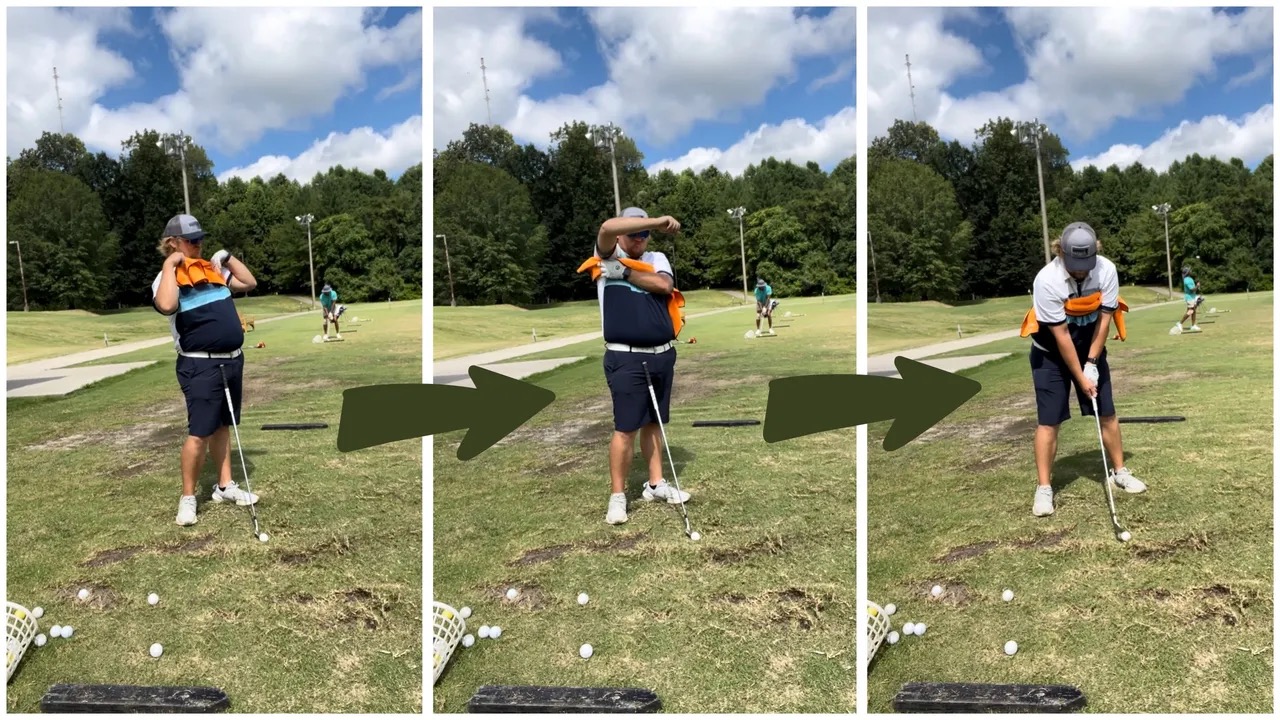
Get a Better Shoulder Turn
Many of us struggle to have proper shoulder rotation in our golf swing, especially during long layoffs. Making a swing that is all arms and no shoulders is a surefire way to have less control with wedges and less distance with full swings. Notice how I can get in a similar-looking position in both 60° wedge photos. However, one is weak and uncontrollable, while the other is strong and connected. One allows me to use my larger muscles to create my swing, and one doesn’t. The follow-through is another critical point where having a good connection, as well as solid shoulder rotation, is a must. This drill is great for those who tend to have a “chicken wing” form in their lead arm, which happens when it becomes separated from the body through impact.
In full swings, getting your shoulders to rotate in your golf swing is a great way to reinforce proper weight distribution. If your swing is all arms, it’s much harder to get your weight to naturally shift to the inside part of your trail foot in the backswing. Sure, you could make the mistake of “sliding” to get weight on your back foot, but that doesn’t fix the issue. You must turn into your trial leg to generate power. Additionally, look at the difference in separation between my hands and my head in the 8-iron examples. The green picture has more separation and has my hands lower. This will help me lessen my angle of attack and make it easier to hit the inside part of the golf ball, rather than the over-the-top move that the other picture produces.
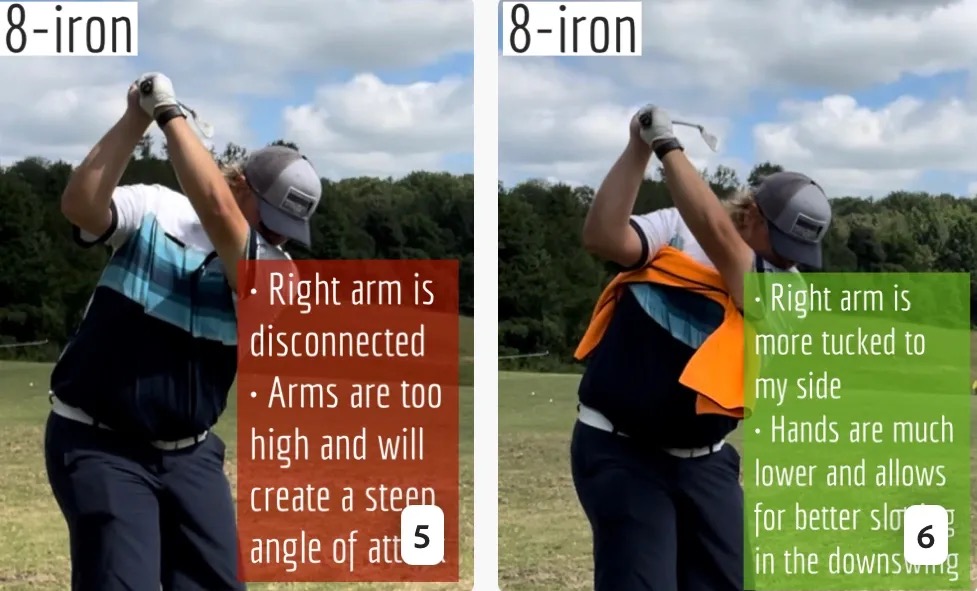
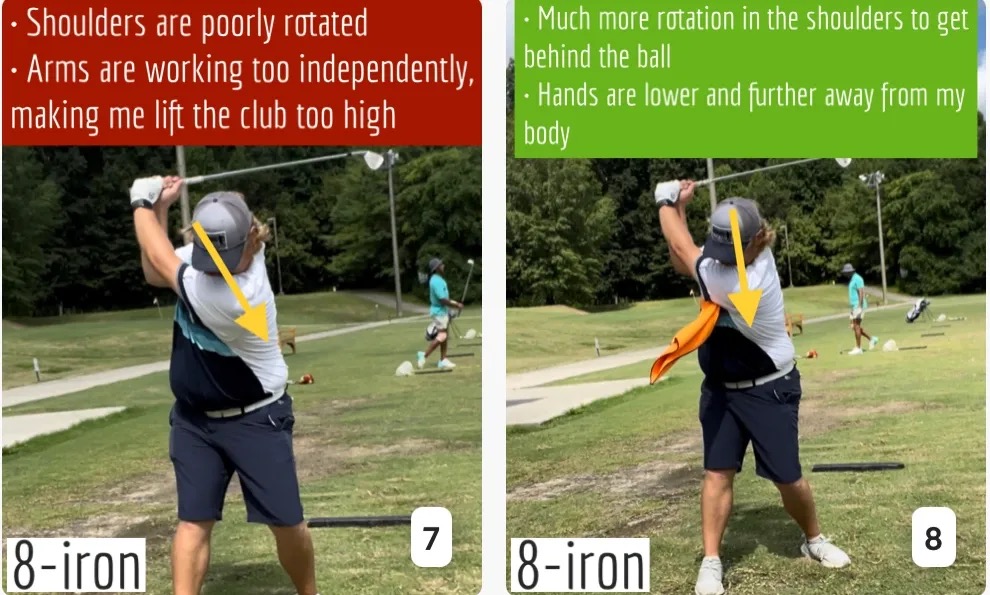
Stay Better Connected in the Backswing
When you don’t keep everything in your upper body working as one, getting to a good spot at the top of your swing is very hard to do. It would take impeccable timing along with great hand-eye coordination to hit quality shots with any sort of regularity if the arms are working separately from the body.
Notice in the red pictures of both my 60-degree wedge and 8-iron how high my hands are and the fact you can clearly see my shoulder through the gap in my arms. That has happened because the right arm, just above my elbow, has become totally disconnected from my body. That separation causes me to lift my hands as well as lose some of the extension in my left arm. This has been corrected in the green pictures by using this drill to reinforce that connection. It will also make you focus on keeping the lead arm close to your body as well. Because the moment either one loses that relationship, the towel falls.
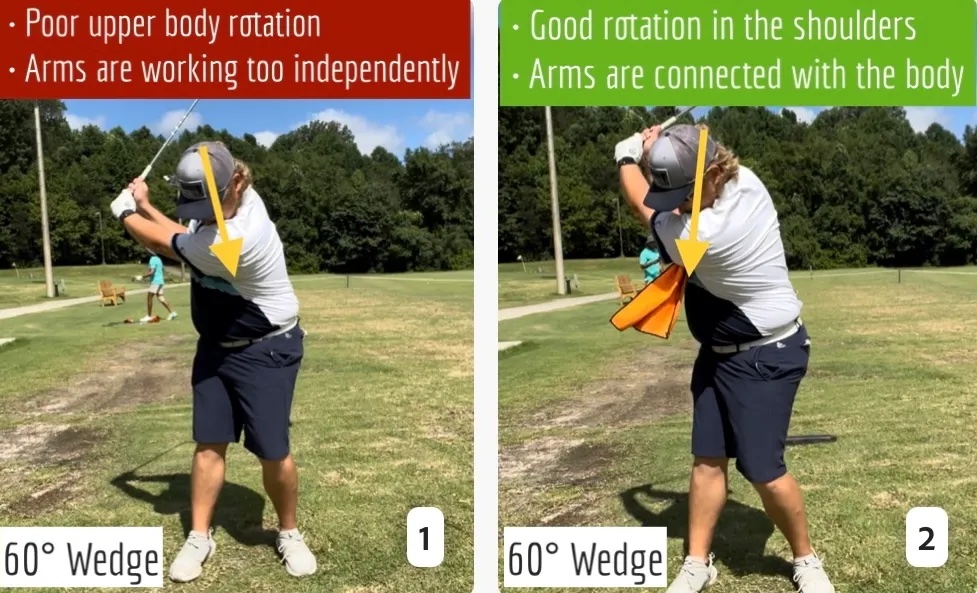
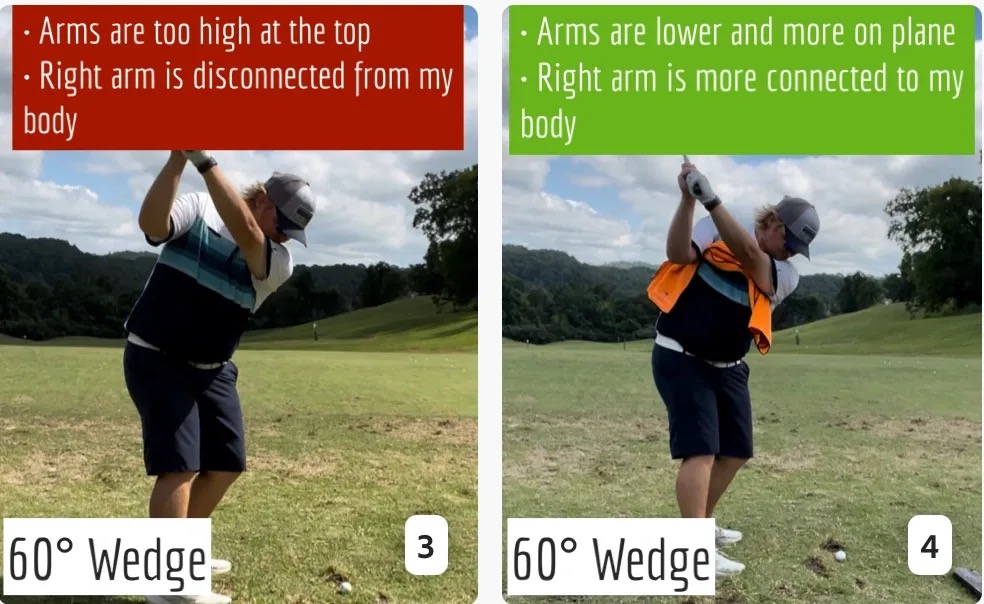
Conclusion
I have been diligent this year in finding a few drills that target some of the issues that plague my golf game; either by simply forgetting fundamental things or by coming to terms with the faults that have bitten me my whole career. I have found that having a few drills to fall back on to reinforce certain feelings helps me find my game a little easier, and the “towel drill” is most definitely one of them.
- LIKE12
- LEGIT2
- WOW2
- LOL0
- IDHT0
- FLOP2
- OB0
- SHANK8
-

 19th Hole7 days ago
19th Hole7 days agoDave Portnoy places monstrous outright bet for the 2024 Masters
-
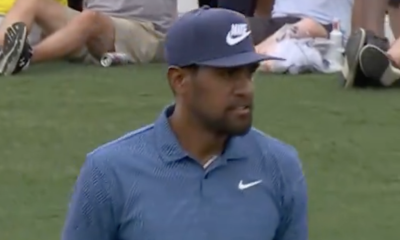
 19th Hole2 weeks ago
19th Hole2 weeks agoThings got heated at the Houston Open between Tony Finau and Alejandro Tosti. Here’s why
-

 19th Hole1 week ago
19th Hole1 week agoTiger Woods arrives at 2024 Masters equipped with a putter that may surprise you
-

 19th Hole2 weeks ago
19th Hole2 weeks agoReport: Tiger Woods has ‘eliminated sex’ in preparation for the 2024 Masters
-

 19th Hole2 days ago
19th Hole2 days agoTwo star names reportedly blanked Jon Rahm all week at the Masters
-

 19th Hole2 days ago
19th Hole2 days agoNeal Shipley presser ends in awkward fashion after reporter claims Tiger handed him note on 8th fairway
-

 19th Hole2 weeks ago
19th Hole2 weeks agoAddiction, spinal fusion, and scam artists – Everything Anthony Kim revealed in candid interview with David Feherty
-

 19th Hole2 weeks ago
19th Hole2 weeks agoAnthony Kim says doctors told him that he ‘may not have much time left’ ahead of LIV return
















